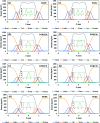Fullerene translocation through peroxidized lipid membranes
- PMID: 35423238
- PMCID: PMC8694942
- DOI: 10.1039/d1ra00272d
Fullerene translocation through peroxidized lipid membranes
Abstract
Recent cytotoxicity research suggests that fullerenes can enter the cell and cross the blood-brain barrier. However, the underlying toxicity mechanism behind the penetration of fullerenes through biological membranes is still not well understood. Here we perform coarse-grained molecular dynamics simulations to investigate the interactions of fullerenes and their polar derivatives (Janus) with model regular and peroxidized bilayers. We show that the translocation of fullerenes and their residence time in bulk water vary depending on the bilayer's peroxidation degree and fullerene polarity. The distribution of fullerenes inside the bilayer is mainly determined by the peroxidation degree and the saturation level of lipid acyl chains. The transport of pristine fullerenes through bilayers occurs at nano timescale while the complete diffusion may not be achieved for Janus fullerenes in micro timescale. As for the toxic response of fullerenes in terms of membrane damage, no mechanical disruption of model bilayers is observed throughout the studied simulation times.
This journal is © The Royal Society of Chemistry.
Conflict of interest statement
The authors declare no competing financial interest.
Figures









References
-
- Kroto H. W. Allaf A. W. Balm S. P. Chem. Rev. 1991;91:1213–1235. doi: 10.1021/cr00006a005. - DOI
-
- Collavini S. Delgado J. L. Sustainable Energy Fuels. 2018;2:2480–2493. doi: 10.1039/C8SE00254A. - DOI
-
- Zhang J. Terrones M. Park C. R. Mukherjee R. Monthioux M. Koratkar N. Kim Y. S. Hurt R. Frackowiak E. Enoki T. Chen Y. Chen Y. Bianco A. Carbon. 2016;98:708–732. doi: 10.1016/j.carbon.2015.11.060. - DOI
LinkOut - more resources
Full Text Sources
Research Materials

